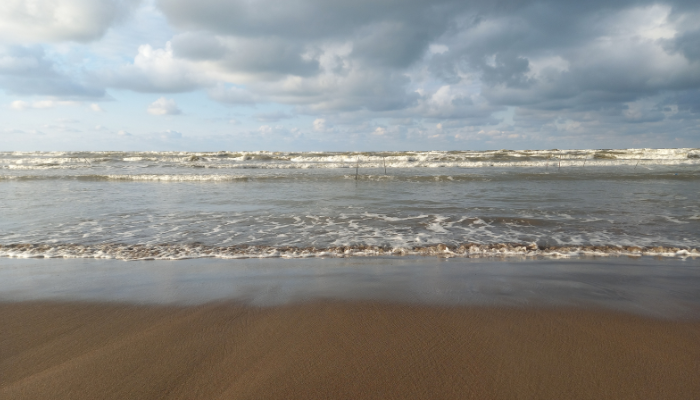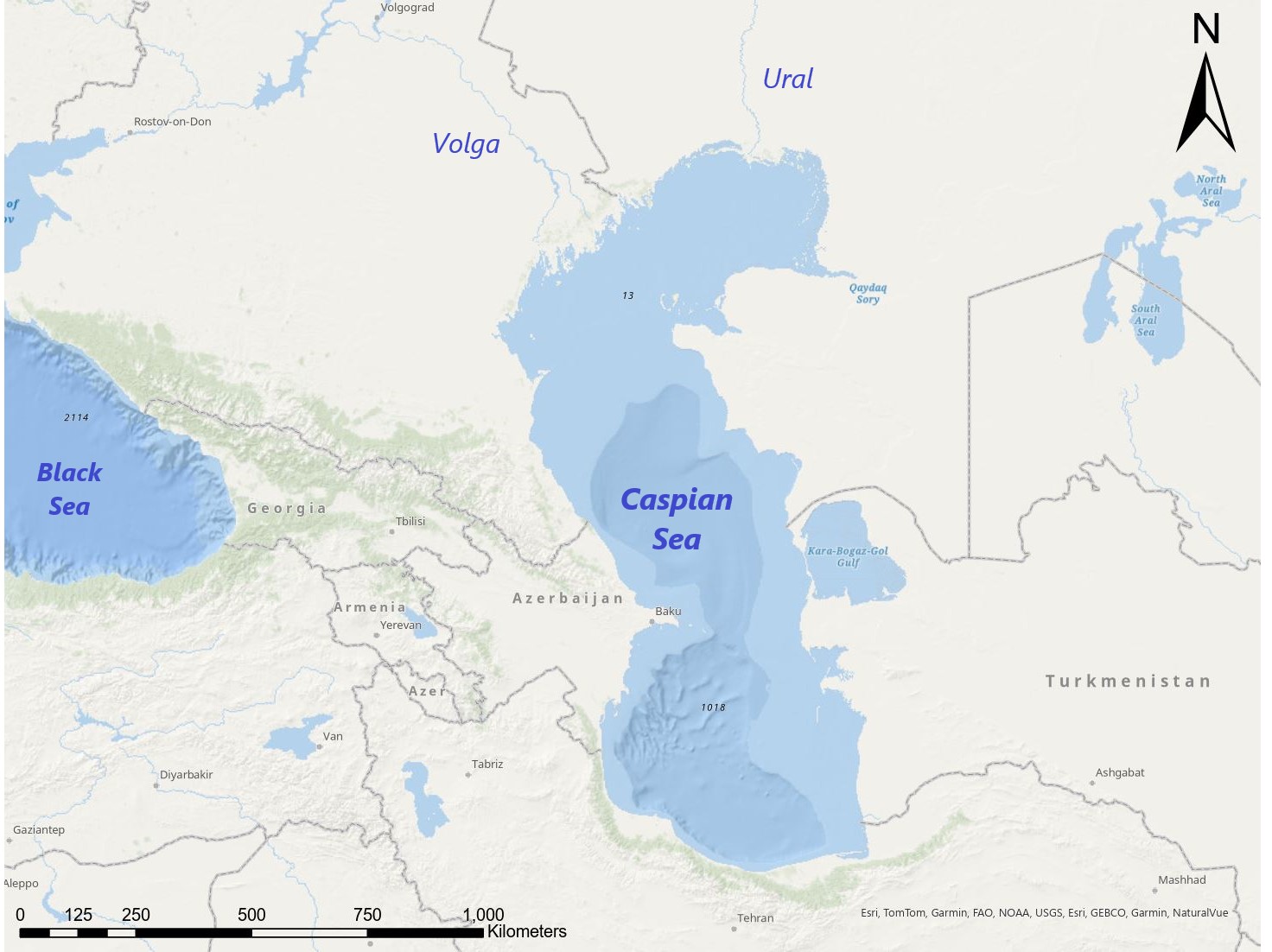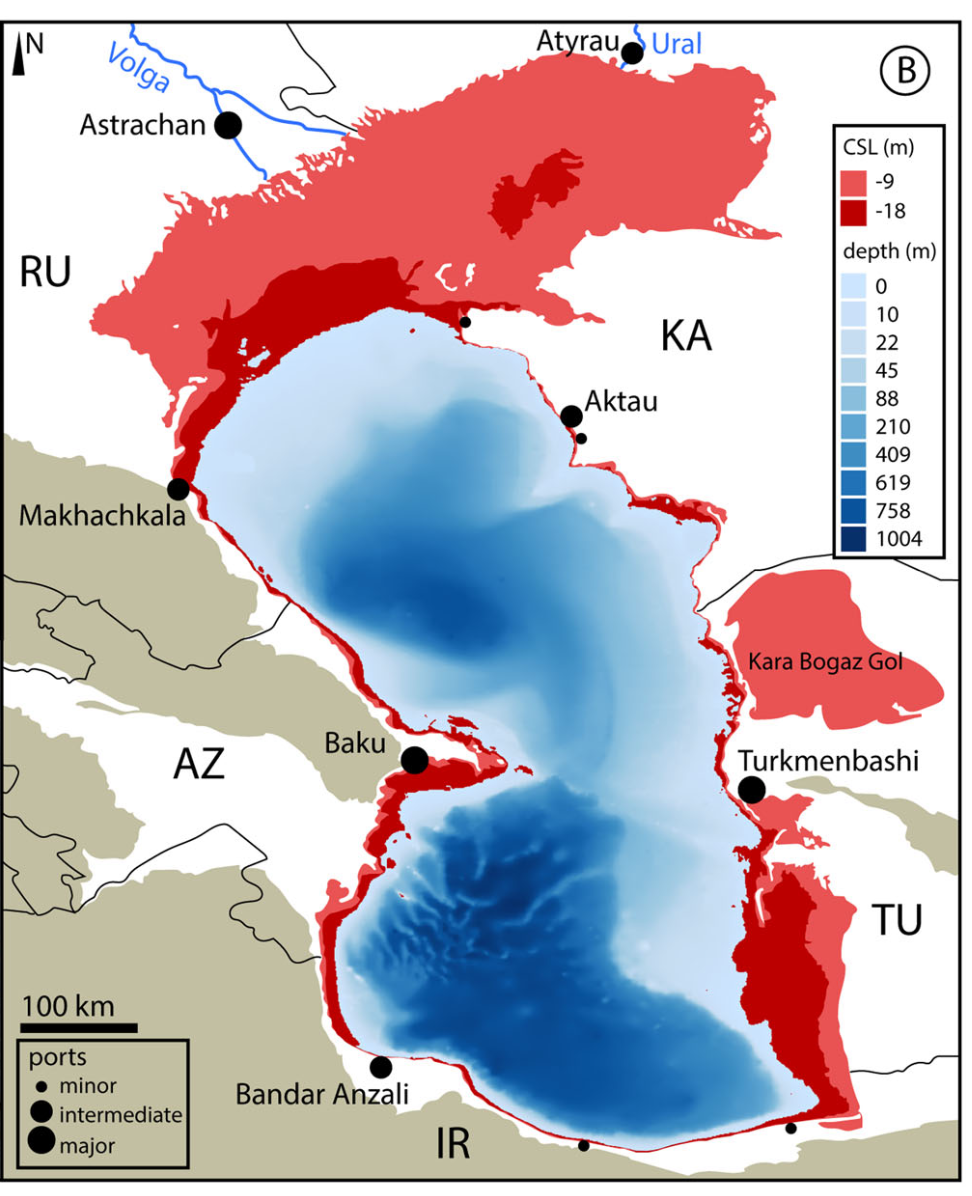
The peril of rising sea levels due to global climate change is evident, posing significant threats. Conversely, inland seas and lakes experience declining water levels, exacerbated by heightened evaporation and diminishing inflows, presenting alarming consequences. Between 1992 and 2020, 53% of global inland water bodies experienced significant declines Currently, several lakes worldwide, such as Lake Urmia and Poyang Lake in Asia, Lake Chad and Lake Rukwa in Africa, Lake Gregory in Australia, the Great Salt Lake in North America, and Lake Mar Chiquita in South America, face similar fates. The Caspian Sea, the largest enclosed sea globally, exemplifies one such case.
The Caspian Sea – The Biggest Lake in the World
The Caspian Sea is the largest lake on Earth, situated about 27 meters below sea level, with its deepest point reaching a depth of 1023 meters. Despite being called a sea, it is actually a lake because it is not connected to any oceans.
To the west lie the Caucasus region, and to the east, the vast steppes of central Asia. It spans across five countries: Turkmenistan to the east, Kazakhstan to the northeast, Russia to the northwest, Azerbaijan to the west, and Iran to the south. About 130 rivers discharge into the Caspian Sea. The Volga River, Europe’s longest river, contributes 80%-90% of the inflow water discharging into the sea. Covering an area of approximately 370,000 km2, it holds a volume of almost 76,000 km3. Accounting for 40-44% of the world’s total lake waters, the Caspian Sea hosts diverse fauna and flora and shelters numerous endangered species, including an estimated 90% of the world’s remaining sturgeon population and Caspian seal.

Location of the Caspian Sea.
Caspian Sea Shrinkage
Over the past decades, the water level of the Caspian Sea has experienced a significant decrease. From 1993 to 2023, its water level dropped by 2 meters. This decline is reminiscent of the Aral Sea disaster during the USSR era, often referred to as the Aral Sea Syndrome. Aral Sea Syndrome is often invoked when lakes dry up due to severe water overuse and mismanagement.
Scientists predict further rapid declines in water levels in the coming decades due to unsustainable development and climate change. Research conducted at the Centre for Marine Environmental Sciences at the University of Bremen in Germany, using Global Climate Models, indicates that under a mid-emission scenario, the Caspian Sea’s surface area could shrink by 23%, with a 9-meter drop in sea level. Under a high-emission scenario, it would shrink by 34% with an 18-meter drop, potentially leading to the drying-out of the shallow zone in the northern part of the sea by the end of the 21st century.
Also, this could endanger protected areas and wetlands such as Gorgan Bay, the largest gulf in the Caspian Sea, and the Kara-Bogaz-Gol, a highly saline lagoon. The resulting dust production from drying wetlands and retreating coastlines could also adversely affect regional weather patterns and human health.

Climate projections for the 21st century based on Global Climate Models, showcasing mid (-9 m) and high emission (-18 m) scenarios (Prange et al. 2020).
How to Halt the Drying of the Caspian Sea
Lack of awareness, particularly among politicians and stakeholders, presents a significant danger. This issue underscores the urgent need for a global awareness campaign. However, this endeavour must be preceded by comprehensive studies examining various aspects of the sea’s depletion. It is crucial to acknowledge that millions of people reside around the Caspian Sea, and its drying up could lead not only to environmental disaster but also to politically and socially complex situations.
Since 1950, water usage from the rivers feeding the Caspian Sea has increased considerably, driven by demands from agriculture, hydropower, industry, and urban needs. This surge in usage has been facilitated by extensive dam construction and river regulation, significantly altering the water influx regime into the sea. For example, Russia recently constructed several dams on the Volga and Ural Rivers. It is estimated that the total water volume of the dam reservoirs in the basin is about 210 km³. These changes also have negatively impacted the life cycles of aquatic animals.
Global warming has exacerbated the situation, causing a 30% increase in evaporation rates compared to previous levels. Additionally, precipitation, which accounts for nearly 15% of the sea’s water input, has been experiencing a slight decreasing trend of approximately 1 mm per year. This shrinkage is partly due to global warming, emphasizing the importance of all countries reducing their greenhouse gas emissions. Additionally, water overuse and decreasing water inflow to the sea contribute to this phenomenon.
Introducing mitigation strategies and nature-based solutions is imperative to halt this process and promote sustainable development. All countries should follow the 2030 United Nations Sustainable Development Goals (SDGs). A successful example of nature-based solutions is Iran’s revival of Gorgan Bay, the largest bay of the Caspian Sea. Additionally, international collaboration and political will are crucial. Also, it is essential to monitor the use of water from rivers feeding the Caspian Sea through explicit programs. Sustainable agriculture practices, relying on species that require less water, should replace water-intensive methods, such as rice cultivation, which is prevalent in the Caspian Sea basin but is not environmentally sustainable. Furthermore, the construction of large dams that disrupt river connectivity must be halted, and alternative, sustainable methods for water provision should be pursued.
To support these efforts, new technologies like Digital Twin can help decision-makers simulate and evaluate different strategies effectively, ensuring informed and effective actions to address the drying of the Caspian Sea. By fostering a deeper understanding and implementing effective measures, we can collectively address the challenges posed by the drying up of the sea and pave the way towards a more resilient future

Sunset at the Caspian Sea at Zibakenar, Gilan Province, Iran. Photo credit: Author.


Hootan
It was a very helpful article, how could general people raise awareness about this issue? At the end actions should be taken at the level of politicians but it looks like they are not waking up!